Wisconsin is a stunning and diverse state in the upper Midwestern region of the US. It is located between the Great Lakes and the Mississippi River and has a vast and rugged landscape with thick forests, glacial lakes, and rich farmland and plains. There are many different animals in Wisconsin – both large and small. Some of the most abundant animals are snakes, with 21 different species native to the state, including two that are venomous. It’s a good idea to know which snakes you might come across if you’re out exploring, so let’s discover more about the black snakes in Wisconsin!
Timber Rattlesnake (Crotalus horridus)
The timber rattlesnake is the largest venomous snake in the state. Timber rattlesnakes are large snakes usually ranging between 36 and 60 inches long. They have dark brown bodies which are overlaid with a series of black or dark brown crossbands, though some timber rattlesnakes are almost entirely black, which rendering their markings virtually indistinguishable. Timber rattlesnakes’ are a species of special concern, only occurring in Western / Southwestern Wisconsin. They prefer forests and woodland edges, especially areas with rocky outcroppings where they can bask in the sun. Although they are not naturally aggressive, these snakes have long fangs that contain a large amount of venom.
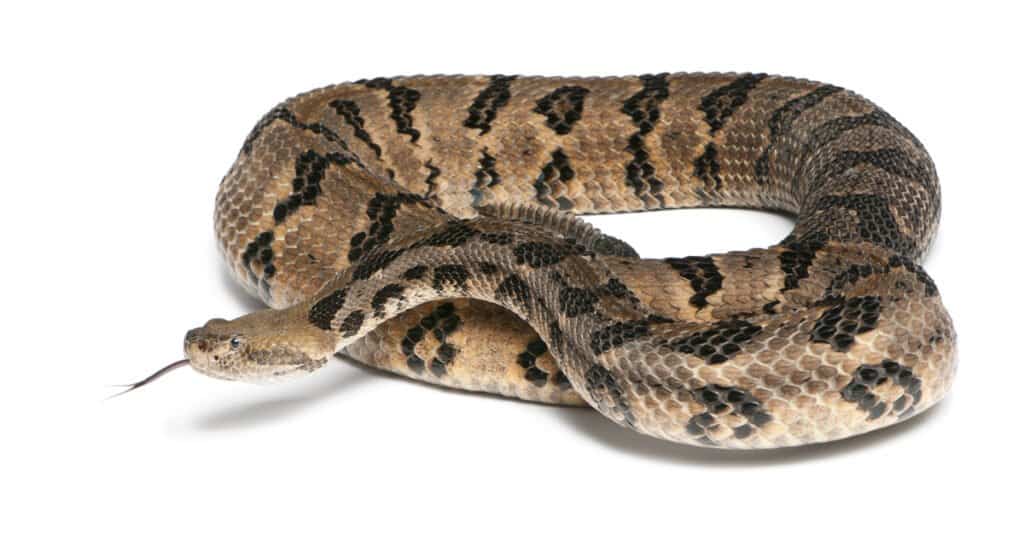
Timber rattlesnakes are large snakes usually ranging between 36 and 60 inches long.
©Eric Isselee/Shutterstock.com
2. Plains Garter Snake (Thamnophis radix)
Another species of special concern is the plains garter snake which lives in wetland areas, upland prairies, and old fields in the Southern region of the state. Plains garter snakes average 36 inches long and have black or brown bodies with orange and/or yellow stripes. They also have black bars on their lips. Plains garter snakes are active from mid-March to early November and give birth to live young between July and August. They are not venomous and mainly prey on amphibians, worms, and slugs. However, they also sometimes eat small birds and small mammals, too.

Plains garter snakes average 36 inches long and have black or brown bodies with orange and/or yellow stripes.
©Alyssa Metro/Shutterstock.com
Gray Rat Snake (Pantherophis spiloides)
The gray rat snake, which is entirely black in the Northern part of its range (including Wisconsin), is gray with grayish black blotches, in the Southern reaches of its range. Gray rat snakes are usually 36 to 72 inches long and are powerful constrictors that prey on small mammals and birds. Gray rat snakes are another species of special concern and only occur in the Southwestern corner of the state. They are highly arboreal and mainly live in forests, although they can often inhabit barns in June where sparrows and swallows are nesting. They are active beween April and October, and juveniles hatch in September shortly before they overwinter.

Gray rat snakes are another species of
special concernand only occur in the Southwestern corner of the state..
©dkHDvideo/Shutterstock.com
Bullsnake (Pituophis catenifer sayi)
One of the longest snakes in Wisconsin is the bullsnake which averages 48 to 72 inches long, but can be quite a bit longer. Bullsnakes are a subspecies of the gopher snake and have yellow bodies with dark brown and black blotches. They are powerful snakes that kill by constriction. Bullsnakes prey on small mammals and birds, but as they are able climbers, they often raid birds nests. Bullsnakes are a species of special concern in Wisconsin and only live in counties along the Western border and in the Southwestern region. They typically inhabit sand and bluff prairies as well as oak savannas. They often overwinter in small mammal burrows or in deep fissures between rocks.
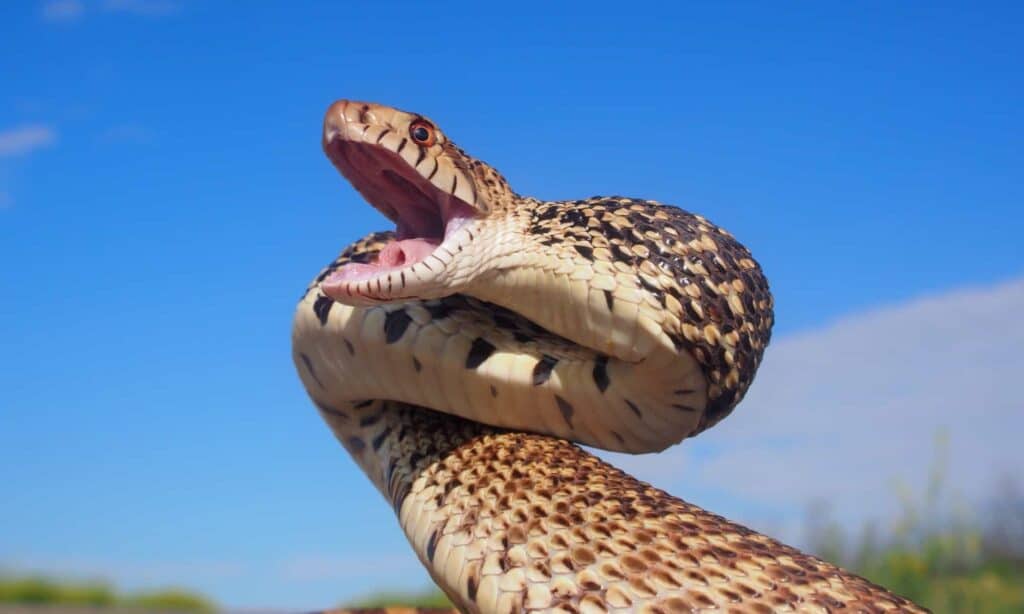
One of the longest snakes in Wisconsin is the
bullsnake
which averages 48 to 72 inches long, but can be quite a bit longer,
©Markparker1983/Shutterstock.com
Fox Snake (Pantherophis vulpinus)
Another large snake is the fox snake which is 36 to 72 inches long. These snakes are golden to tan brown and have dark brown to black blotches as well as a yellow and black bellies. Fox snakes get their name from the foul musk scent that they give off, which strongly resembles the scent given off by foxes. They are widespread across the entire state and live in open habitats – such as marshes, meadows, and prairies. Fox snakes are often mistaken for rattlesnakes because they have a habit of vibrating their tail in the leaf litter. They are also sometimes mistaken for the venomous copperhead, although copperheads are not found in Wisconsin. Fox snakes themselves are not venomous and have a fairly docile temperament.
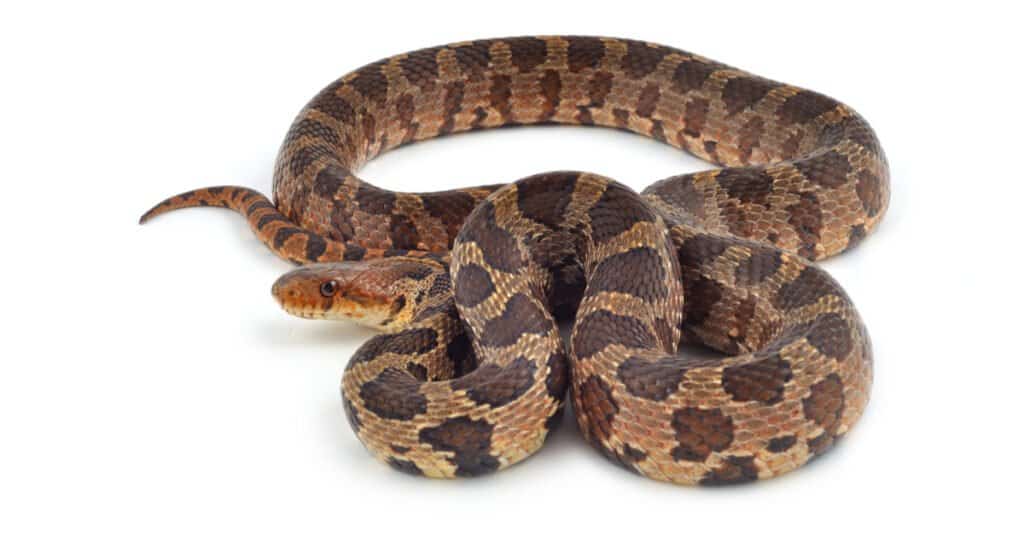
Fox snakes are not venomous and have a fairly docile temperament.
©James DeBoer/Shutterstock.com
Northern Water Snake (Nerodia sipedon)
Another black snake in Wisconsin is the northern water snake which has a tannish/brown body with darker crossbands and blotches. They are large snakes with a heavy body and average 24 to 40 inches, although they can reach 54 inches long. Northern water snakes are found state wide and occur in virtually any wetland habitat, where they prey on a range of fish and amphibians. Although Northern water snakes are not venomous they are often mistaken for and killed as a result of their strikingly similar appearance to the venomous cottonmouth snake. However, cottonmouths are not found in Wisconsin.
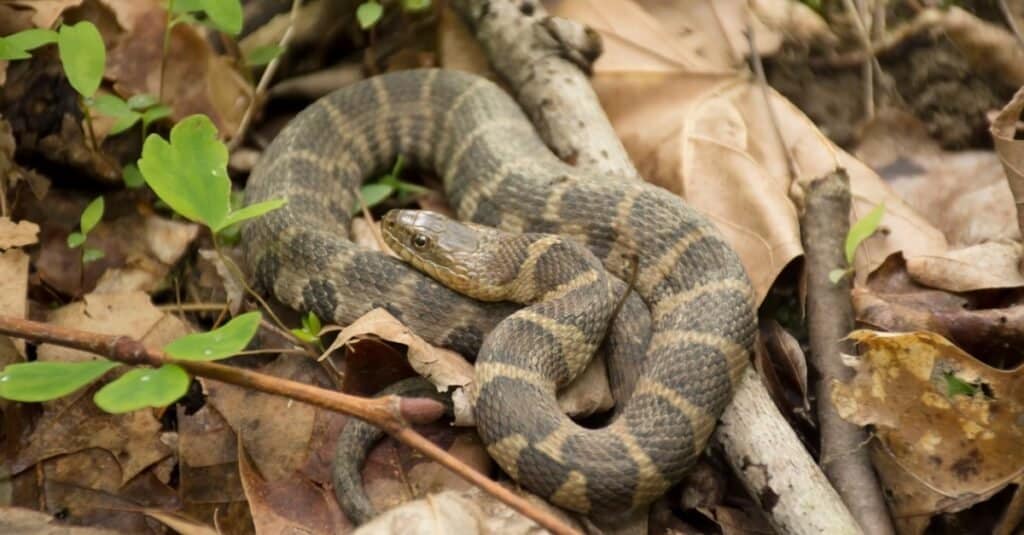
The northern water snake has a brownish black body with darker crossbands and blotches.
©iStock.com/IcemanJ
Common Garter Snake (Thamnophis sirtalis)
The second garter snake on this list is the common garter snake which is the most common snake in Wisconsin. Common garter snakes are found across the state and live in a variety of habitats. However, they are most common near forests and wetlands where they prey on a selection of amphibians, worms, fish, lizards, birds, and rodents. Common garter snakes are typically 17 to 26 inches long. They are black or brown with cream or yellow stripes and the occasional red markings between the stripes.

Common garter snakes are typically 17 to 26 inches long.
©iStock.com/randimal
Massasauga Rattlesnake (Sistrurus catenatus)
The massasauga rattlesnake is the other venomous snake to call Wisconsin home, and is a threatened species within the state. They are 24 to 30 inches long and have tan or grey bodies with large dark brown or black blotches. Massasaugas live in the Western and Southern regions of the state, mainly near floodplain habitats, upland prairies, and old fields. These snakes contain cytotoxic venom which is more potent that that of the timber rattlesnake. However, due to their smaller size, and therefore smaller venom yield, they are not considered as dangerous the timber rattler.
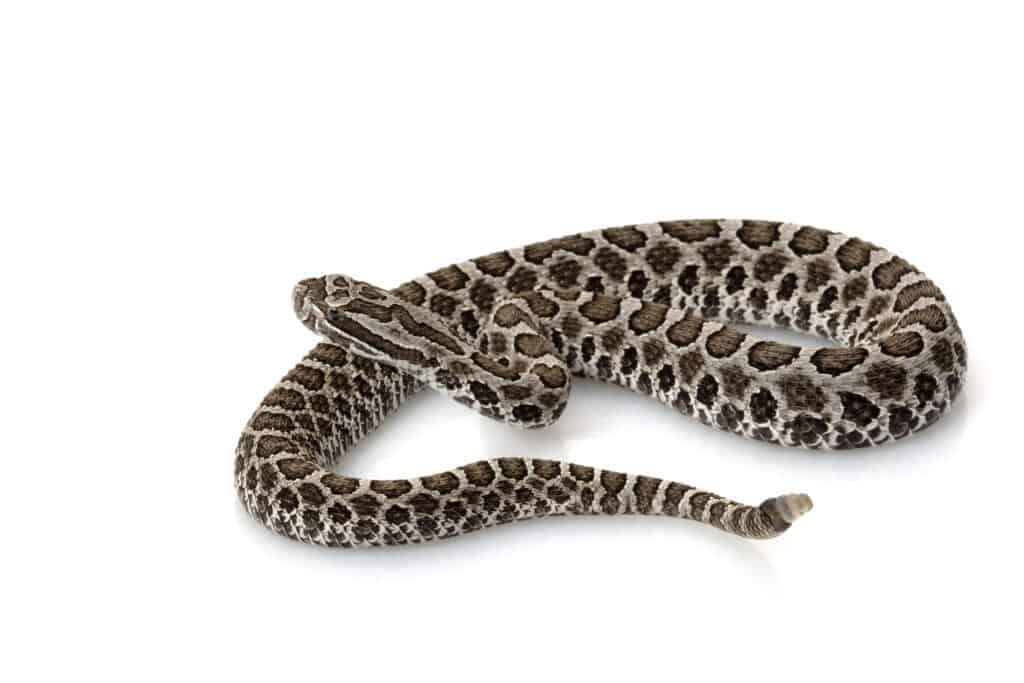
Massasauga rattlesnakes are 24 to 30 inches long and have tan or grey bodies with large dark brown or black blotches.
©fivespots/Shutterstock.com
Eastern Ribbon Snake (Thamnophis sauritus sauritus)
A subspecies of the ribbon snake, the Eastern ribbon snake has a slender body which is 7 to 34 inches long. They are black with yellow stripes along their back and sides. Eastern ribbon snakes are mainly diurnal and are active from mid-March through to mid-November. They are an endangered species in the state and occur near shallow bodies of water – such as swamps, streams, and ponds – in scattered locations. They are not venomous and prey on a range of fish and amphibians.
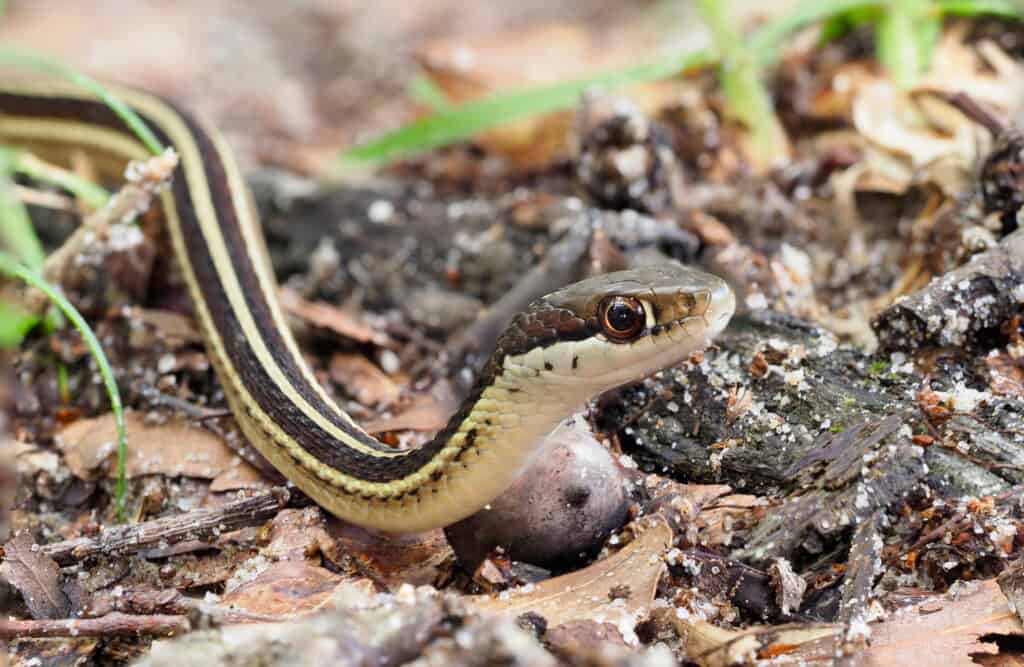
The Eastern ribbon snake has a slender body which is 7 to 34 inches long.
©Steve Bower/Shutterstock.com
Ring-Necked Snake (Diadophis punctatus)
The ring-necked snake is one of the smallest snakes in Wisconsin, at only 10 to 20 inches long. Ring-necked snakes have a distinctive appearance with a glossy black body and a bright ring of color around their neck. This neck ring can be either red, orange, or yellow. They also sometimes have a belly that isthe same color as their ring. Ring-necked snakes are nocturnal, as well as shy and secretive, which means that they are not easily spotted. They live in woodlands and forests and on bluff prairies. There are two subspecies that are native to Wisconsin – the Northern and the prairie ring-necked snake. The Northern subspecies is common across the state. However, prairie ring-necked snakes are a species of special concern as they are only found in the Southwest corner of the state.
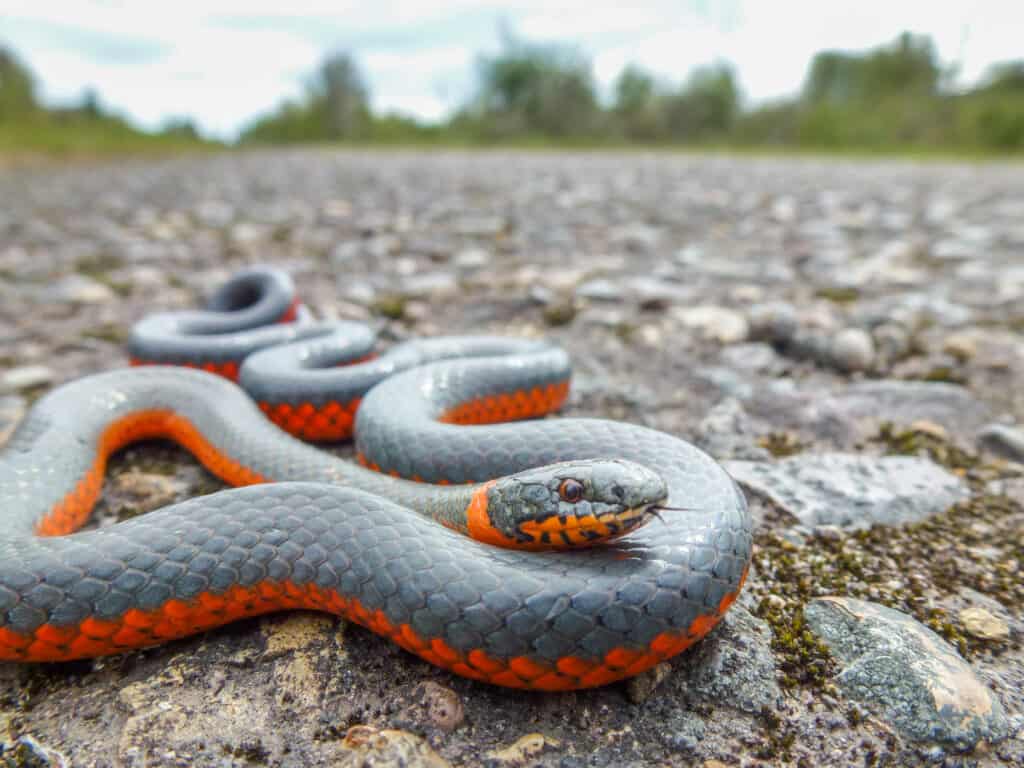
Ring-necked snakes are nocturnal, as well as shy and secretive.
©Tom Fenske/Shutterstock.com
Up Next
- Discover the 2 Types of Rattlesnakes in Wisconsin
- 22 Snakes in Wisconsin
- Discover the 7 Largest Animals in Wisconsin, and Where You’ll Find Them
- Discover the 8 Most Dangerous Animals in Wisconsin, and Where You’ll Find Them
The photo featured at the top of this post is © fivespots/Shutterstock.com
Sources
- dnr.wi.gov, Available here: https://dnr.wi.gov/topic/WildlifeHabitat/herps.asp?mode=table&group=Snakes#:~:text=Many%20snake%20populations%20have%20declined,endangered%2C%20threatened%20or%20special%20concern.
Thank you for reading! Have some feedback for us? Contact the AZ Animals editorial team.






